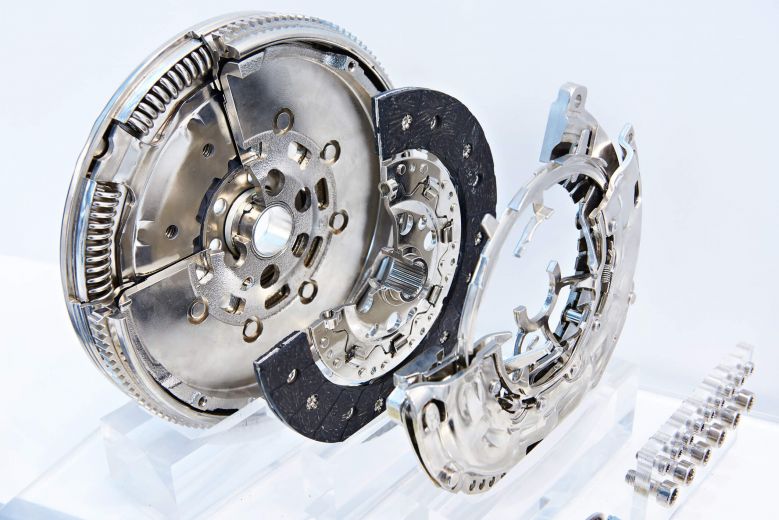The DMF also makes your car easier to drive and more comfortable on long journeys, with smoother gearchanges and reduced noise and vibrations in the cabin. Knowing how your car works is important, as the DMF can be susceptible to wear, tear and mechanical failure.
In this guide, we look at the inner working of the dual mass flywheel, as well as, any costs associated with repairing or replacing it should it fail.
What is a dual mass flywheel (DMF)
A dual mass flywheel is found in many types of vehicles and is used to absorb shock loads and vibrations that occur when the engine is running.
Although it normally is in use during gear changes in manual engines, or when the vehicle is moving at low speeds – it is something that is constantly in use when the vehicle has been turned on.
Commonly found in diesel or high-performance petrol cars, the DMF also is vital when there are large fluctuations in torque.
The overall design of all types of dual mass flywheels allows them to absorb and dissipate energy more effectively, resulting in smoother engine operation and reduced wear on the transmission and other engine components.
How does a dual mass flywheel work?
A dual mass flywheel works by connecting two flywheels, connected by springs and complex machinery, to allow them to work independently from each other to absorb impact and vibrations from an engine that is in operation.
One flywheel is linked to the crankshaft. The other works with the clutch and transmission. Both of these work together to make the vehicle move.
Heavy vibrations or sudden violent shocks can seriously damage an engine – and cost thousands of pounds to fix – so keeping them in perfect working condition is something all drivers should be aware of.
By removing the large vibrations, it makes changing gears easier for the driver. It does this largely though powerful springs and absorbers within the flywheels.
Why is the dual mass flywheel making a noise?
Due to the strain that the dual mass flywheel is put under by engines over many years and thousands of miles, they can develop wear and tear problems.
A DMF that makes a loud rattling sound or squeak is a sign that it is failing and will need replacing.
Over time, the springs and flywheels can be severely worn due to driving style, level of maintenance, and how long they have been in use.
Visit your trusted local garage to see how they can help.
Symptoms of a faulty dual mass flywheel
If your dual mass flywheel is faulty, then there are some common symptoms you should be aware of – and know what to do if it starts causing issues when you are behind the wheel.
Aside from a loud rattling sound or squeak from the engine, there are a few other signs.
- Dashboard warning light: If you notice one of your engine warning light symbols appear in front of you, it could indicate a problem with your dual mass flywheel
- Engine shaking: Problems with the DMF will remove the barrier in place to avoid violent jerking and vibrations in the engine
- Changing gear: A damaged DMF will make it harder for the driver to change gear
- Clutch problems: If the pedal feels spongy and unresponsive – of it the clutch is slipping – it could indicate that there is too much wear and tear on the DMF
- Loss of power: When accelerating and changing gears, the DMF should be most active – and if there is a loss of performance, then it will be a common issue relating to the DMF
If you are experiencing any of these problems, it could be a sign that your DMF needs replacing. It could also highlight that there is a wider problem in the engine.
Call a mobile mechanic or take your vehicle to a local garage to get the bottom of the problem.
How long does a dual mass flywheel last?
A dual mass flywheel should have a lifespan of over 100,000 miles in most vehicles.
However, this can vary due to a variety of factors such as driving style, quality of the components, level of maintenance, and the current standard of the parts that are linked to the DMF.
Dual mass flywheel and clutch kit
When it comes to replacing your DMF, you will likely need to buy a dual mass flywheel and clutch kit.
This includes both flywheels, springs, absorbers, clutch disc, clutch pressure plates, bearings, flywheel bolts, and alignment tools.
Some kits may also come with their own locking tools.
It is important to check that the parts are compatible with your vehicle before purchasing the kit.
The work should be carried out by a qualified mechanic.
Cost to repair dual mass flywheel
Although it is possible to repair a single flywheel, if both are damaged then the DMF will need to be replaced.
Single flywheels can be resurfaced by a mechanic – but replacing them is the best option for the owner of the vehicle.
Cost of new dual mass flywheel
Replacing a dual mass flywheel can be expensive for car owners – with prices starting from around £700 and can be over £1,500 for higher spec makes and models.
If the works involves carrying out a clutch replacement, then it can be significantly more.
Get a service or repair at home
RAC Mobile Mechanics can come to you, saving you the hassle of going to a garage.












